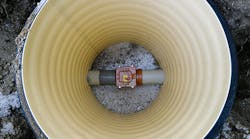VPPPA 2016: Five Takeaways about OSHA's Subpart AA of 29 FR 1926 Confined Space Standard
OSHA’s Subpart AA of 29 FR 1926 rule addresses the construction industry or worksites which are “continuously evolving with the number and characteristics of confined spaces changing as work progresses,” according to the agency’s website.
The new rule specifically addresses permit-defined spaces, which are defined as:
- containing or has the potential to contain a hazardous atmosphere
- containing material that has the potential to engulf an entrant
- having walls that converge inward or floors that slope downward and taper into a smaller area which could trap or asphyxiate an entrant
- containing any other recognized safety or health hazard, such as unguarded machinery, exposed live wires, or heat stress.
Pat Furr, corporate safety officer, Roco Rescue, went into detail about the differences between the 1910 general industry standard and new Subpart AA 1926 construction standard and when each is appropriate to use in a non-construction setting. Here are five takeaways from his presentation at the 32nd Annual VPPPA Safety & Health Conference.
1. Communicate, communicate, communicate.
"Unfortunately, we’re still seeing the fatalities in confined space situation,” Furr said. “In more cases than not, it was just a breakdown in communication.”
2. Do more than the minimum and cover all confined spaces, not just permit spaces.
Subpart AA mainly addresses permit-required spaces, but companies should apply to all confined spaces to maintain a safe standard across the board, Furr said.
3. Immediately train all incoming employees and provide continuous training and education opportunities.
“Can we just assume the guy with the pink slip talked to the guy walking in with the boots, gloves and overalls?”
4. When in doubt, follow the more protective standard.
Construction firms aren’t the only companies doing construction work. So, when in doubt in a situation with general industry, more provisions are better.
“OSHA states the minimum, but when it comes to safety do you just want to do the minimum? Subpart AA offers more protection and additional provisions for confined spaces.”
5. Understand and communicate the nature of the hazard and what PPE is needed if rescue needs to happen.
“Leaving a hazard behind, I think, is criminal,” Furr said. “There’s no reason a hazard shouldn’t be communicated.”
To read more from OSHA about confined spaces, click here.
